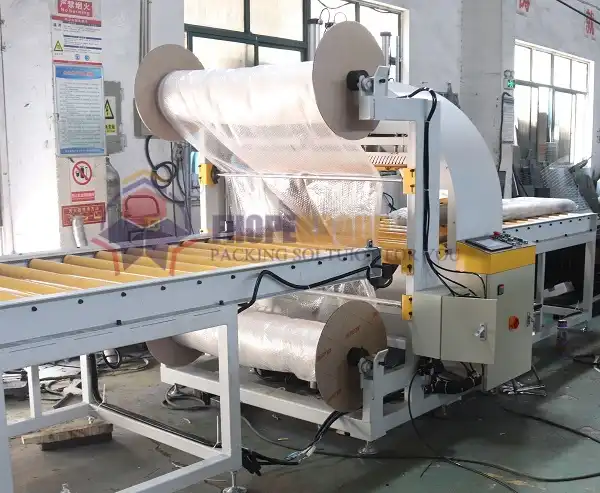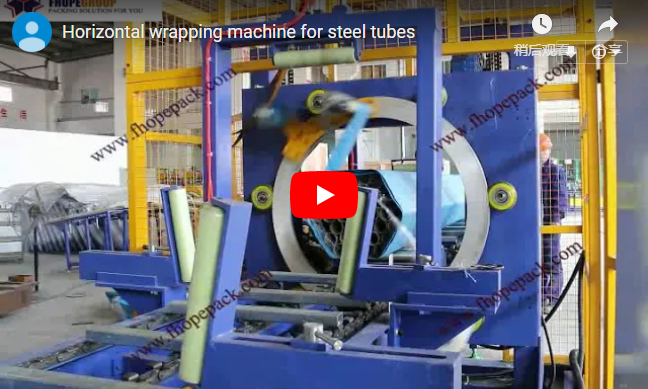Enhancing Steel Tube Protection and Efficiency with Horizontal Orbital Wrapping Machines
Steel tubes, pipes, and other long products are fundamental components in numerous industries, from construction to manufacturing. However, their length and susceptibility to surface damage, corrosion, and deformation during storage and transportation present significant packaging challenges. Traditional manual wrapping methods are often slow, inconsistent, and labour-intensive. Horizontal orbital wrapping machines offer a sophisticated, automated solution designed specifically to address these issues.
1. What is a Horizontal Orbital Wrapping Machine?
A horizontal orbital wrapping machine, also known as a pipe wrapping machine or ring wrapper, is an automated packaging system engineered to apply protective films like stretch wrap, VCI (Volatile Corrosion Inhibitor) film, or paper around long, cylindrical or irregularly shaped products such as steel tubes, pipes, bundles of profiles, timber, and more. Unlike turntable wrappers, the product moves horizontally through a rotating ring that dispenses the wrapping material, ensuring complete and consistent coverage along the entire length.

2. The Wrapping Process: How It Works
Understanding the sequence of operations highlights the machine's efficiency:
- Infeed: Steel tubes or bundles are placed onto the machine's infeed conveyor system, either manually or automatically.
- Positioning: The product moves into the wrapping zone, centered within the rotating ring. Sensors detect the product's presence to initiate wrapping.
- Orbital Wrapping: The vertically oriented ring, carrying the roll of wrapping material, rotates around the stationary or slowly advancing product. As it rotates, the film is dispensed and applied tightly around the tubes. The conveyor speed and ring speed are synchronized to control the wrap overlap.
- Overlap Control: The degree of overlap (typically adjustable from 10% to 90%) determines the level of protection and material consumption. Higher overlap provides greater moisture and dust resistance.
- Cutting and Clamping: Once the product has passed entirely through the ring, an automated system typically cuts the wrapping material and clamps the end, securing the wrap tightly.
- Outfeed: The fully wrapped steel tubes exit the machine via the outfeed conveyor, ready for storage or shipment.
3. Key Technical Specifications and Features
When evaluating horizontal orbital wrappers for steel tubes, consider these critical parameters:
- Product Dimensions:
- Tube Diameter Range: Typically accommodates diameters from 50mm up to 500mm or more, depending on the model.
- Tube Length Range: Can handle lengths from 2 meters often up to 12 meters or longer, with customization possible.
- Bundle Size Capacity: Specify the maximum cross-section dimensions for bundled products.
- Machine Performance:
- Wrapping Ring Speed: Variable, often ranging from 50 to 150 RPM, directly impacting throughput.
- Conveyor Speed: Adjustable, usually between 3 to 15 meters per minute, synchronized with ring speed for desired overlap.
- Wrapping Material Compatibility:
- Material Types: Stretch film (LLDPE), VCI-infused stretch film, woven plastic sheeting, paper, or composite materials.
- Roll Width: Standard widths (e.g., 100mm, 250mm) supported by the ring's dispensing unit.
- Roll Outer Diameter: Maximum roll size the machine can accommodate.
- Control System:
- PLC (Programmable Logic Controller): For reliable automation and process control.
- HMI (Human-Machine Interface): Typically a touch screen for easy operation, parameter adjustments (overlap, tension, speeds), and diagnostics.
- Construction and Power:
- Frame: Heavy-duty steel construction for durability in industrial environments.
- Power Requirements: Standard industrial voltages (e.g., 380V/415V, 3-Phase, 50/60Hz).
- Optional Features:
- Top Press-Down Rollers: Stabilize loose bundles during wrapping.
- Automatic Film Cut & Clamp Unit: Enhances automation and safety.
- Safety Fencing & Light Curtains: Ensures operator safety during operation.
- Conveyor Integration: Seamless connection with existing production or handling lines.
4. Benefits: Why Invest in Orbital Wrapping for Steel Tubes?
Implementing a horizontal orbital wrapping machine translates to tangible operational advantages, based on industry experience:
- Superior Product Protection: Provides a tight, uniform wrap that shields steel tubes from moisture, dust, dirt, scratches, and physical damage during handling and transit. Using VCI film offers crucial corrosion prevention, significantly reducing rust formation – a major concern for steel products.
- Increased Packaging Efficiency: Dramatically faster than manual wrapping, increasing throughput and reducing labor costs associated with packaging. Consistent wrapping quality eliminates variability inherent in manual processes.
- Optimized Material Usage: Precise control over film tension and overlap minimizes material waste compared to manual application, leading to cost savings.
- Enhanced Load Stability & Bundling: Effectively bundles multiple tubes together, creating stable units that are safer and easier to handle, stack, and transport.
- Improved Workplace Safety: Automates a physically demanding task, reducing the risk of repetitive strain injuries and accidents associated with manually handling large rolls of film and maneuvering around long products.
- Professional Presentation: Securely wrapped products present a more professional image to customers, reinforcing quality standards.
5. Common Applications
Horizontal orbital wrappers are indispensable in:
- Steel Mills and Processing Plants
- Steel Service Centers and Distributors
- Pipe and Tube Manufacturers
- Metal Fabrication Shops
- Logistics and Shipping Operations handling long products
6. Choosing the Right Wrapping Material
The choice of wrapping material depends on the level of protection required:
- Standard Stretch Film (LLDPE): Provides good protection against dust, dirt, and moisture, and offers excellent load containment.
- VCI Stretch Film: Contains Volatile Corrosion Inhibitors that create a protective molecular layer on the steel surface, preventing rust during long-term storage or overseas shipping. Essential for high-value or sensitive steel grades.
- Woven Material/Paper: Can offer enhanced puncture resistance or specific barrier properties.
7. Conclusion
Horizontal orbital wrapping machines represent a significant upgrade for packaging operations dealing with steel tubes and similar long products. By automating the wrapping process, they deliver substantial improvements in protection (especially against corrosion with VCI films), efficiency, cost-effectiveness, and safety. Investing in the right machine, tailored to specific product dimensions and throughput requirements, ensures steel tubes reach their destination in optimal condition, safeguarding product value and customer satisfaction.
For more detailed information on specific models and customization options, explore our range of Horizontal Wrapping Machines.


